Lorenzo DiTommaso
Concordia University
Jewish Pseudepigrapha and Christian Apocrypha:
Definitions, Boundaries, and Points of Contact
Only in the past few decades has the study of biblical apocrypha begun to transcend the balkanisation imposed on it for a variety of historical and theological reasons. Although certain distinctions among the categories remain important, it is now clear that they do not automatically warrant the rigid classification of the corpus of apocryphal literature on the basis of chronology, canon, or confession. This paper examines two of these historical categories, the Jewish Pseudepigrapha and the Christian Apocrypha, with the goal of identifying avenues and approaches by which current research on the first collection of texts might inform the study of the second. The paper focuses on the related issues of definitions, terminology, and boundaries, and on the confirmed and potential points of contact between the two collections.
Evans discussed the Gospel of Thomas, the (so-called) Gospel of Peter, Papyrus Egerton 2, and Secret Mark.Craig A. Evans
Acadia Divinity College
The Apocryphal Jesus:
Assessing the Possibilities and Problems
The debate surrounding the usefulness of the extracanonical Gospels for historical Jesus research is a long one, which in one form or another can be traced back to the early church. One thinks especially of second, third, and fourth-century Fathers who appeal to various Gospels or Gospel recensions in commentaries, treatises, and apologetic works, consciously supplementing, even modifying the tradition of the canonical Gospels. In some ways what these early Christian theologians and apologists were doing was not much different from the objectives and activities of the modern research. The present study undertakes a critical investigation of the status of the question today, advocating an openness to the possibility of early, reliable tradition in these texts, but at the same time urging greater caution in their use.
Michael Kaler
McMaster University
Gnostic Irony and the Adaptation of the Apocalyptic Genre
For gnostic authors as for other early Christians, Jewish and Christian apocalyptic writings were valued sources of information and inspiration. Apocalyptic works provided their readers with information about the true meaning of history, the nature of the cosmos, and humanity’s origins and destiny. The influence of apocalyptic works, and of the canons of the apocalyptic genre, on gnostic writings of all sorts is clear. But one of the fundamental elements of apocalyptic writings was a glorification of the creator-God, a divinity whose status gnostic works radically downgraded. The tension caused by this basic difference in attitudes towards the creator-God and his creation led to the ironic reappropriation of the norms of the apocalyptic genre on the part of some authors. In this paper, I will examine this reappropriation as manifested in the gnostic Apocalypse of Paul and the Apocalypse of Adam.
Here are a few of the many photographs I took. You can click on any of them to get a larger image.

Candid group photo taken on Saturday. The waiter pushed the button prematurely and also had his finger on the lens. Sorry everyone, but the other two were even worse. The baby in the front row is Katerina, daughter of Cornelia Horn and Rob Phenix. She was the quietest, most contemplative baby I've ever met.
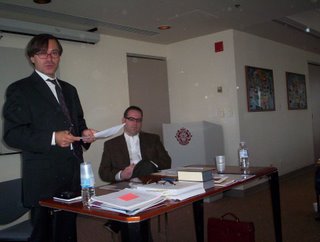
Pierluigi Piovanelli (l) and Lorenzo DiTommaso (r) in the opening session.

Michael Kaler presents.
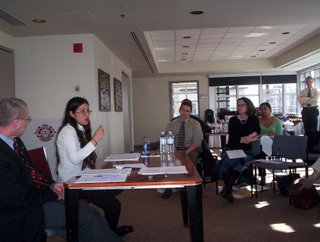
Annette Reed presents.
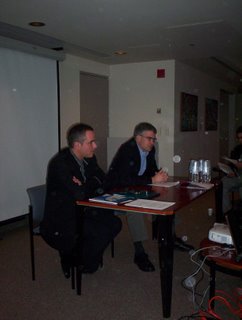
Craig Evans presents. Dominique Côté (l) chairs the session.
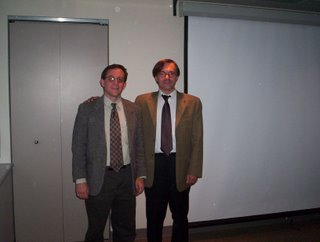
Davila and Piovanelli at the end of the workshop. Fortunately, the massive hayfever attack I suffered all weekend doesn't show here.
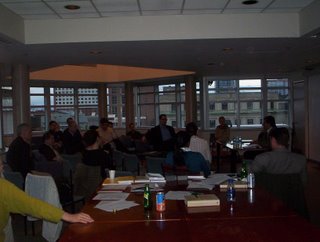
The final meeting of the workshop. This was an important session that may have reprecussions in the field for years to come. (Remember, Davila was there too! -- as usual, behind the camera.) There were preliminary discussions about the possibility of opening a new branch of the European association that focuses on Christian Apocrypha (AELAC -- Association pour l'étude de la littérature apocryphe chrétienne), and producing a new collection of New Testament Apocrypha in English and a collection of introductory essays on the NT Apocrypha. (I know that no one likes the term "New Testament Apocrypha" as a scholarly category, but, like Old Testament Pseudepigrapha, I use it here because it is useful as a shorthand, since people have some idea what it means.)
I have also added a photo [now also the abstract] of the Painchaud session to my post from Sunday.
Once again, this was an extremely successful and well-run conference and it was a privilege to be there. It was a excellent opportunity for English- and French-speaking specialists in the Christian Apocrypha from both sides of the Atlantic to get to know one another and one another's research. Many thanks to Pierluigi for all his hard work in hosting it.
No comments:
Post a Comment